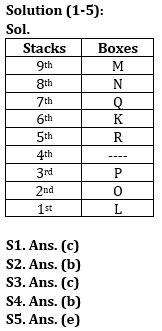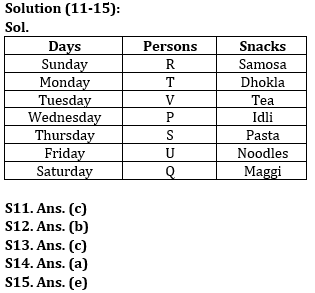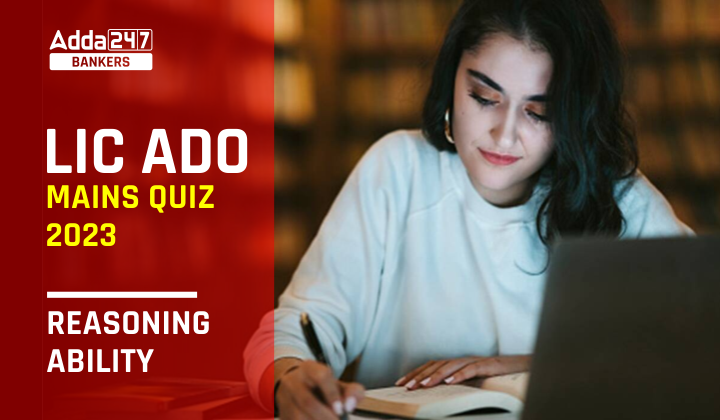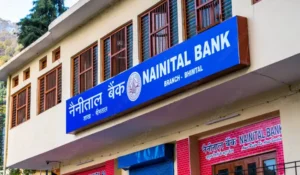Direction (1-5): Study the following information carefully and answer the given questions:
Eight boxes i.e., K, L, M, N, O, P, R and Q are kept one above the other in a stack. The lowermost box is numbered 1, the box above it is numbered 2 and so on until the topmost box is numbered 9. One of the boxes is empty. All the information is not necessarily in the same order.
Note: If one box is kept between box A and box B, then it means that there is a gap of either one stack or two stacks.
Box M is kept at the odd numbered position above the box numbered 6. There is a gap of three boxes between box M and box R. Box K is kept just above the box R. Three boxes are kept between box L and box K. Box L is kept at an odd numbered box. Box O is kept adjacent to the box L. Box N is kept just above the box Q. Two boxes are kept between box Q and the empty box. Box L is not kept at the topmost position.
Q1. Which amongst the following boxes is kept two boxes above the box R?
(a) Box N
(b) Empty
(c) Box Q
(d) Box M
(e) None of these
Q2. How many boxes are kept above the box P?
(a) Four
(b) Five
(c) Three
(d) Six
(e) None of these
Q3. What is the position of box N from the bottommost?
(a) 2nd
(b) 6th
(c) 8th
(d) 4th
(e) None of these
Q4. How many boxes are kept between box O and the one which is kept just above the box K?
(a) Four
(b) Three
(c) Five
(d) Six
(e) None of these
Q5. Four of the following five are alike in a certain way and hence form a group. Who is the one that doesn’t belong to that group?
(a) Q
(b) L
(c) M
(d) P
(e) O
Directions(6-8): In the following questions assuming the given statement to be true, find which of the conclusion(s) among given conclusions is/are definitely true and then give your answers accordingly.
Q6. Statements: V > T; S≤I<G<Q; C<G<V; T<U<N
Conclusions: I. S< V
II. N> G
III. Q>C
(a) Only I and II are true
(b) Only II is true
(c) Only I and III are true
(d) Only I is true
(e) None is true
Q7. Statements: C <X=T; N<E≤ Y=Z; Y<C= P
Conclusions: I. N < X
II. T > E
III. Z<P
(a) Only I and II are true
(b) Only II is true
(c) Only I and III are true
(d) Only I is true
(e) All are true
Q8. Statements: Z ≥ R>D; A> P≥Z; D<K< S
Conclusions: I.A> R
II. D < P
III. K>Z
(a) Only I and II are true
(b) Only II is true
(c) Only I and III are true
(d) Only I is true
(e) None is true
Q9. Which of the following symbols should replace the question mark in the expression given below to make the conclusions” E<D and K>B” definitely true?
K > D ≥ G ? Y ≥ E ? B > J
(a) ≥, =
(b) >, <
(c) >, >
(d) <, >
(e) None of these
Q10. Which of the following pair of symbols should be placed in the place of question marks respectively (in same order from left to right) in order to complete the given expression in such a manner that W < N is definitely true?
U > N ≥ O _ V _ K = W
(a) <, >
(b) ≥, <
(c) ≤, <
(d) >, ≥
(e) None of these
Directions (11-15): answer the questions based on the information given below.
Seven persons P, Q, R, S, T, U and V attend the seminar on one of the days in a week from Sunday to Saturday. Each of them likes different snacks i.e., Samosa, Noodles, Maggi, Pasta, Idli, Dhokla and Tea but not in the same order.
At most two persons attend the seminar before T who likes Dhokla. The number of persons who attend the seminar before the one who likes Tea is same as the number of persons who attend after S. V neither attends seminar on Wednesday nor on Saturday. Only two persons attend the seminar between T and the one who likes Pasta. U who likes Noodles attends immediately before Q. R likes Samosa but he does not attend the seminar on Wednesday. S attends the seminar one of the days after Wednesday. Q neither attends the seminar on Friday nor does he like Idli. P attends seminar immediately before the one who likes Pasta. V doesn’t like Pasta.
Q11. How many persons attend seminar between T and S?
(a) Three
(b) Four
(c) Two
(d) One
(e) None of these
Q12. Who among the following likes Maggi?
(a) V
(b) Q
(c) S
(d) P
(e) None of these
Q13. Who among the following attends the seminar immediately before S?
(a) The one who likes Tea
(b) The one who attends the seminar on Friday
(c) The one who likes Idli
(d) The one who likes Pasta
(e) None of these
Q14. Which snacks does V like?
(a) Tea
(b) Pasta
(c) Maggi
(d) Samosa
(e) None of these
Q15. Which among the following statement(s) is/are true?
(a) Q likes Tea
(b) Q attends the seminar on Thursday
(c) Q attends immediately before P
(d) Q does not like Maggi
(e) None of these
Solutions

S6. Ans.(c):
Sol. I. S < V – True
II. N > G – False
III. Q > C – True
S7. Ans.(e):
Sol.I. N < X – True
II. T > E- True
III. Z < P- True
S8. Ans.(a):
Sol. I. A > R – True
II. D < P – True
III. K > Z – False
Solution (9-10):
S9. Ans.(c):
Sol. Given expression: K>D ≥G? Y≥E?B>J
So, in option c, symbols make the expression (E <D, K>B) definitely true in the given expression.
S10. Ans.(d):
Sol. After checking each of the given options we get option d is the correct answer.






 Profit, Loss & Discount – Concept + ...
Profit, Loss & Discount – Concept + ...
 Nainital Bank Recruitment 2025-26 Notifi...
Nainital Bank Recruitment 2025-26 Notifi...
 Daily Current Affairs Quiz 13 December 2...
Daily Current Affairs Quiz 13 December 2...








